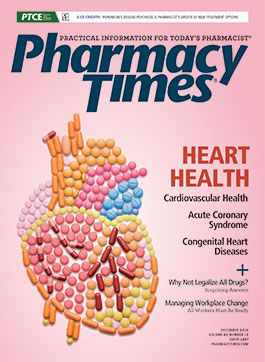Publication
Article
Pharmacy Times
Hypertension: Revealing the Silent Killer
Author(s):
Hypertension is a leading modifiable risk factor for heart disease and stroke.
Hypertension is a leading modifiable risk factor for heart disease and stroke.1 According to the CDC, between 2011 and 2014, one-third of adults 18 years and older had hypertension, which was uncontrolled (>140/90 mm Hg) in 47% of these patients. The prevalence of hypertension is highest in elderly patients (Table 12), non-Hispanic African American patients (Table 22), and males (Table 32; Table 4).

SCREENING AND DIAGNOSIS
The US Preventive Services Task Force recommends screening for high blood pressure (BP) every 3 to 5 years in adults aged 18 to 39 years with normal BP (<130/85 mm Hg) and every year for adults 40 and older at increased risk (BP 130-139/85-89 mm Hg, overweight or obese, African American).5
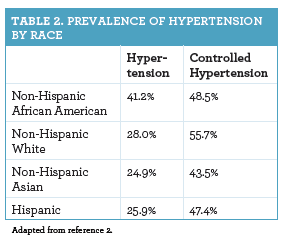
A diagnosis of hypertension is made with at least 2 BP readings >140/90 mm Hg. If the clinic BP is ≥140/90 mm Hg, a second reading should be obtained with 24-hour ambulatory BP monitoring or home BP monitoring. It is suitable to begin treatment without a second reading if a patient exhibits signs of severe hypertension or organ damage (eg, headache, altered mental status, nausea, vomiting, chest pain, left ventricular hypertrophy, chronic kidney disease, hypertensive retinopathy).6
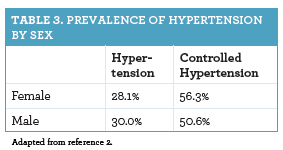
GUIDELINES FOR MANAGING HYPERTENSION; BLOOD PRESSURE GOALS
According to the Report from the Panel Members Appointed to the Eighth Joint National Committee (JNC 8), the treatment goals for adults are as follows7:
• Younger than 60 years: <140/90 mm Hg
• 60 years and older: <150/90 mm Hg
• All adults with diabetes or chronic kidney disease: <140/90 mm Hg
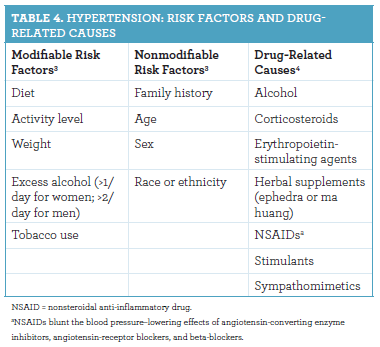
The JNC 8 guideline released in 2013 is the gold standard clinical practice guideline for the management of hypertension (Table 5). The American Society of Hypertension, in conjunction with the International Society of Hypertension (ASH/ ISH), also offers a clinical practice guideline, which was published in 2013. The 2 guidelines are similar; however, the ASH/ISH guideline has stages 1 and 2 hypertension designations similar to the JNC 7 guideline and a systolic BP treatment target of 150 mm Hg beginning at age 80 (instead of 60). Also, unlike the JNC 8 guideline, the ASH/ ISH guideline recommends beta-blockers as firstline treatment for patients with coronary artery disease and heart failure.8
The exercise and diet options in Table 610 are recommended prior to, or in conjunction with, pharmacologic interventions. The projected effects on BP persist as long as the lifestyle option is sustained and may serve as an additional motivator for patients.
INITIAL PHARMACOLOGIC THERAPY AND CLINICAL PEARLS
The goal of hypertension management is to attain and maintain the target BP. If the goal is not reached within a month of initial pharmacotherapy with 1 agent, one of the following strategies may be used:
• Titrate to maximum dose and then add a second drug
• Add a second drug before achieving maximum dose of the initial drug
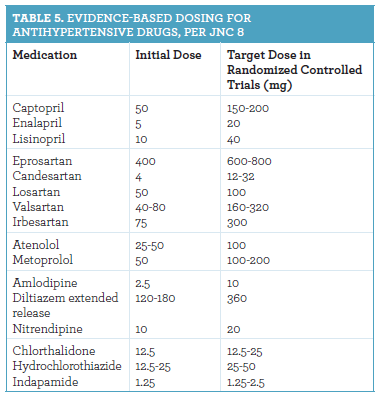
Another possible option is to initiate 2 drugs at the same time. This is especially recommended when the systolic BP is >160 mm Hg and/or the diastolic BP is >100 mm Hg. If the target BP is not achieved with 2 drugs, select a third drug and titrate it to the maximum recommended dose. See online table 7 for possible initial agents and population-specific recommendations.7,9
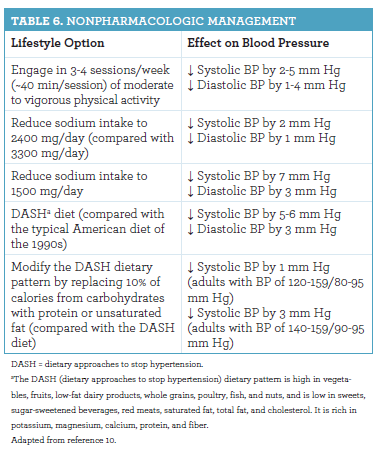
ADHERENCE
Hypertension is known as the silent killer due to its asymptomatic nature.11 About 40% of patients discontinue their medications during their first year of treatment.4 Inappropriate adherence leads to higher morbidity, adverse events, and increased costs. Strategies to improve adherence include motivational interviewing (addressing patient’s fears, valued outcomes, and societal pressures), detailed drug education (including likelihood of adverse effects), discussing adherence during every office and pharmacy visit, telephone counseling, reducing pill burden/daily frequency, and using combination pills.12
Table 7. Initial and Population-Specific Therapy
Therapy
Clinical Pearls
Initial antihypertensive treatment should include thiazide-type diuretics, a CCB, an ACE inhibitor, or an ARB alone or in combination.
- An ACE inhibitor and an ARB should never be used in combination.
- After a myocardial infarction, an ACE inhibitor or an ARB may be more appropriate.
- For patients with heart failure, thiazide-type diuretics are more effective than a CCB or an ACE inhibitor. ACE inhibitors have been more effective than CCBs.
- Thiazide-like diuretics, chlorthalidone and indapamide, are significantly more potent than the thiazide-type diuretic hydrochlorothiazide at similar dose levels.
In the general African American population, including those with diabetes, initial antihypertensive treatment should include a thiazide-type diuretic or a CCB alone or in combination.
- Regarding thiazides vs ACE inhibitors: thiazides are more effective in improving cerebrovascular, heart failure, and combined cardiovascular outcomes.
- Regarding CCBs vs ACE inhibitors: ACE inhibitors have a 51% higher rate of stroke in African American patients and are less effective in reducing blood pressure.
- Regarding treatment in the general African American population vs treatment of African Americans with diabetes, comparisons were not reported between ACE inhibitors and CCBs.
In patients with chronic kidney disease, initial antihypertensive treatment should include an ACE inhibitor or an ARB alone or in combination with another drug class, regardless of race or diabetes status.
- This recommendation applies to patients with or without proteinuria.
- It is based on improved kidney outcomes and less evidence for improved cardiovascular outcomes.
- There is no evidence to support ACE inhibitor or ARB use in patients older than 75 years. ACE inhibitors or ARBs, as well as thiazide-type diuretics and CCBs, may be beneficial.
ACE inhibitor = angiotensin-converting enzyme inhibitor; ARB = angiotensin-receptor blocker; CCB = calcium channel blocker.
END NOTE
Hypertension should be approached as a modifiable risk factor for comorbid conditions. Pharmacists should continue to help optimizing pharmacotherapy, promoting adherence, and identifying drug-related causes. Lifestyle modifications should be emphasized for all patients, with and without hypertension.
Melissa Atocha, PharmD, is a 2016- 2017 PGY-1 OLE health ambulatory care resident. Mohamed Jalloh, PharmD, is an assistant professor at Touro University California.
References:
- Heart disease and stroke. Healthy People 2020 website. healthypeople.gov/2020/topics-objectives/topic/heart-disease-and-stroke#three. Accessed October 11, 2016.
- Hypertension prevalence and control among adults: United States, 2011-2014. CDC website. cdc.gov/nchs/data/databriefs/db220.htm. Published 2015. Updated October 28, 2015. Accessed October 11, 2016.
- High blood pressure risk factors. CDC website. cdc.gov/bloodpressure/risk_factors.htm. Published July 2014. Updated July 7, 2014. Accessed October 11, 2016.
- Calhoun DA, Jones D, Textor S, et al; American Heart Association Professional Education Committee. Resistant hypertension: diagnosis, evaluation, and treatment. Circulation. 2008;117(25):e510-e526. doi: 10.1161/CIRCULATIONAHA.108.189141.
- Final recommendation statement: high blood pressure in adults: screening. US Preventive Services Task Force website. https://www.uspreventiveservicestaskforce.org/page/document/recommendationstatementfinal/high-blood-pressure-in-adults-screening. Accessed October 11, 2016.
- Hypertension in adults: diagnosis and management. National Institute for Health and Care Excellence website. nice.org.uk/guidance/cg127/resources/hypertension-in-adults-diagnosis-and-management-35109454941637. Published August 24, 2011. Accessed October 11, 2016.
- James PA, Oparil S, Carter BL, et al. 2014 evidence-based guideline for the management of high blood pressure in adults: report from the Panel Members Appointed to the Eighth Joint National Committee (JNC 8). JAMA. 2014;311(5):507-520. doi: 10.1001/jama.2013.284427.
- Mancia G, Fagard R, Narkiewicz K, et al; Task Force Members. 2013 ESH/ESC guidelines for the management of arterial hypertension: the task force for the management of arterial hypertension of the European Society of Hypertension (ESH) and of the European Society of Cardiology (ESC). J Hypertens. 2013;31(7):1281-1357. doi: 10.1097/01.hjh.0000431740.32696.cc.
- Roush GC, Ernst ME, Kostis JB, Tandon S, Sica DA. Head-to-head comparisons of hydrochlorothiazide with indapamide and chlorthalidone: antihypertensive and metabolic effects. Hypertension. 2015;65(5):1041-1046. doi: 10.1161/HYPERTENSIONAHA.114.05021.
- Eckel RH, Jakicic JM, Ard JD, et al; American College of Cardiology/American Heart Association Task Force on Practice Guidelines. 2013 AHA/ACC guideline on lifestyle management to reduce cardiovascular risk: a report of the American College of Cardiology/American Heart Association Task Force on Practice Guidelines. Circulation. 2014;129(25 suppl 2):S76-S99. doi: 10.1161/01.cir.0000437740.48606.d1.
- High blood pressure. CDC website. cdc.gov/bloodpressure. Published 2016. Updated September 13, 2016. Accessed October 11, 2016.
- Laufs U, Rettig-Ewen V, Böhm M. Strategies to improve drug adherence. Eur Heart J. 2011;32(3):264-268. doi: 10.1093/eurheartj/ehq297.
